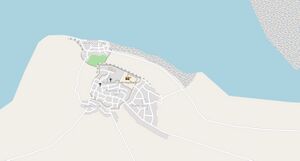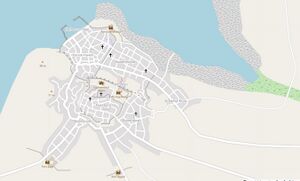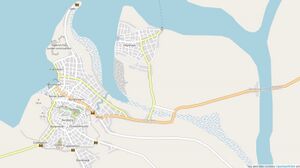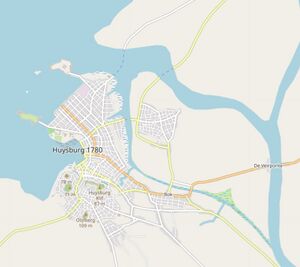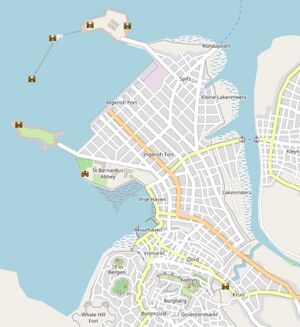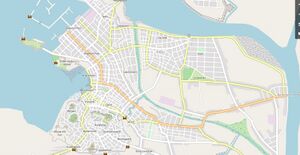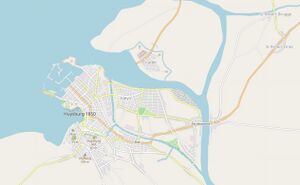Huysburg: Difference between revisions
| Line 38: | Line 38: | ||
The Huysburg port was further developed during the 1840s and 1850s, with several docks being build in the basin. Smaller factories were already spread over the city during the early 1800s; but industrialization only really started in 1842 with the opening of a first textile factory. More followed soon and by 1870 Huysburg was one of the major industrial cities of [[Fayaan]], together with [[Fayaan City]] and [[Witzandmond]]. Industrialization also meant migration of labor forces from the countryside to the city, and from the 1840s on Huysburg gradually increased from a small town to a big city. The new neighbourhouds were mainly constructed north of the city, in the coastal lowlands. North of the Lindedries an upscale neighborhood, called Park, was constructed during the 1840s. Away from the odors and noise of the harbor, it was a garden-city for the wealthy merchants. | The Huysburg port was further developed during the 1840s and 1850s, with several docks being build in the basin. Smaller factories were already spread over the city during the early 1800s; but industrialization only really started in 1842 with the opening of a first textile factory. More followed soon and by 1870 Huysburg was one of the major industrial cities of [[Fayaan]], together with [[Fayaan City]] and [[Witzandmond]]. Industrialization also meant migration of labor forces from the countryside to the city, and from the 1840s on Huysburg gradually increased from a small town to a big city. The new neighbourhouds were mainly constructed north of the city, in the coastal lowlands. North of the Lindedries an upscale neighborhood, called Park, was constructed during the 1840s. Away from the odors and noise of the harbor, it was a garden-city for the wealthy merchants. | ||
== Second industrialization 1870-1910 == | |||
Revision as of 07:39, 6 April 2022
History
Early Colonial Period (1520-1630)
The exact timing of the founding of Huysburg is disputed, but documents from Noordkaap mention a "Huys met Burg ende Have" in 1543, most probably corresponding to Huysburg. A small fortress was build before 1550 as indicated by archaeological findings, while the a wall was build around the hilltop town center around 1575, and around the downtown harbor around 1580. Lentia trading archives from 1594 mention "Huys-by-Burgh" as a small harbor from where wood and fruits were exported. In the early 1600s Huysburg grew as an important trading center for southern Fayaan. New settlements in the Klaarmeer area produced more and more fruits that were exported to Lentia, while the logging industry became a major economic driver for the area. Huysburg became the major ship building town of northern Archanta.
The Leeye River mouth shifted northwards after a major hurricane in 1618, resulting in fast silting up of the harbor area. Several attempts to dredge the harbor failed. A small new harbor community (Kleynhave) developed on the Leeye banks more to the north, while the old harbor became completely useless in 1628.
Late Colonial Period (1630-1720)
In 1629 the governor ordered the construction of a new harbour near the city center. The mudflats north of the city were drained and between 1630 and 1647 a new downtown city centre was built. City walls were extended and a new fort (Fort Domestica) was constructed. The new harbour was also walled with a seawall, partially constructed from stone, protecting the harbour from storms. But the same wall also increased siltation and harbour maintenance costs remained high.
After the Ingerish occupation in 1690, Huysburg remained an importing trading centre. New Ingerish markets opened for trade, and Ingerland further developed farming, logging and mining in the hinterland. But from the early 1700s on more and more trade went to the Fayaan City area.
During the early 1700s further silting up of the bay and harbour posed more and more challenges for the port. The Ingerish further fortified the city, connecting the city walls in the hilly southern suburbs around 1710. The construction of a large seaside citadel was started in 1712, but never finished due to increasing costs and the coastline shifting seawards (making the citadel useless).
East of the Ingerish controlled city centre, Kleynhave developed as a secondary urban centre. It flourished thanks to uncontrolled smuggling. A small fishing port/dock was built around 1695.
Ingerish Expansions 1720-1783
During the late 1710s saltation problems increased, while the population was growing fastly due to the fast development of the hinterland and the Klaarmeer area. A new Ingerish governor, William Clarke, decided on a large urban renewal project. An entire new harbor was build on reclaimed land, protected by seaside forts and a seawall. The new city was flanked by the new Sint Bernardus Abbey and hospital. A fort was built on the Whale Hill in the southern parts of town, while also landside defenses were enforced. The Kleynhave area expanded and became an important transport center, connecting the city with the north through ferries.
The fortified city proved to be well defended against pirate attacks. The city was only to a minor degree involved in the First Independence War (1755-1765), but suffered from the economic crisis caused by the war. During the early stages of the Santa Cruz War (1780-1789) Huysburg rebelled against the Ingerish, even with about 30% of the population being Ingerish. In July 1783 Ingerish troops abandoned the forts, not after setting fire in the Whale Hill fort and the harbor forts. Large parts of the downtown city were sacked and destroyed, due to Ingerish troops fighting with city militia.
Independent Huysburg Governate 1783-1801
After the Ingerish troops left, Huysburg became an independent governate. With the constant threats from pirate attacks and a suffering economy, the city went through tough times. A pirate raid destroyed parts of Kleynhave in 1794, but failed to take the city centre. In 1796 the Union of Northern Munion send a regiment to the Huysburg seaside forts to defend the harbour against raids. A major hurricane in 1799 brought more disaster to the city: some dykes breached and large parts of the Kleynhave area were flooded; the river mouth shifted southward, destroying parts of the Kleynhave settlement.
In 1801 Huysburg joined the Confederate Union of North Munion (from 1806 called Fayaan).
First Republic: slow recovery and industrialisation 1801-1870
Joining the Fayaan confederation allow Huysburg to slowly recover from the turbulent end of the 18th century. Confederate troops brought peace and security. Hinterland agriculture production and mining activities increased again. With neighbouring Hoopsbaai and Yldago Governates still independent, regional tensions remained high which didn't provide an ideal setting for undertakings. After Hoopsbaai joined the confederation the economy picked up again, but Huysburg as a port city was dwarfed by the Hoopsbaai ports.
In 1825 works started on a citadel north of the River Leeye to protect against the Hoopsbaai. Works continued until 1845. The citadel was to become a major landmark in the city for the next decades.
The Huysburg port was further developed during the 1840s and 1850s, with several docks being build in the basin. Smaller factories were already spread over the city during the early 1800s; but industrialization only really started in 1842 with the opening of a first textile factory. More followed soon and by 1870 Huysburg was one of the major industrial cities of Fayaan, together with Fayaan City and Witzandmond. Industrialization also meant migration of labor forces from the countryside to the city, and from the 1840s on Huysburg gradually increased from a small town to a big city. The new neighbourhouds were mainly constructed north of the city, in the coastal lowlands. North of the Lindedries an upscale neighborhood, called Park, was constructed during the 1840s. Away from the odors and noise of the harbor, it was a garden-city for the wealthy merchants.
